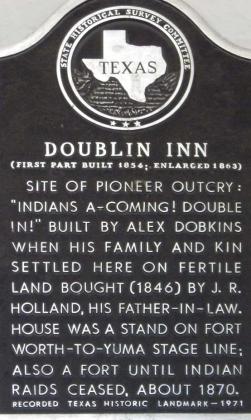It was Oct. 14, 1854 that settlers first came to this place we now call Dublin. The party of settlers consisted of 13 people. They were Mr. and Mrs. A. H. Dobkins.
They came by ox wagons along with their six children. They left Knox County Tennessee in August of 1854 and were joined in Little Rock Arkansas by Mr. and Mrs. Thomas Holland, along with William Holland and two children of Tom Holland. The Hollands and Dobkins came to this section to live on the land that John R. Holland purchased from William Thomas in 1846. The deed was recorded in Fannin County since Erath County had not been organized at that time. The early settlers described their new home as having lush tall grass and a veritable hunters paradise. There was plenty of wild turkey and deer. Resley Creek at that time was teaming with fish. (Dublin Progress, Oct. 8, 1954) Thomas Holland didn’t stay here very long, but moved on to Gatesville where his father owned land. The Dobkins family also moved to Gatesville after two years leaving behind a double cabin. This family later said the doubl-in in the cabin’s name was changed by dropping the “ o” making it Dublin. The Dobkins family returned three years later to find that the Keith and O’Neal families had moved here. A. C. “Alex” Dobkins became known as the founder of Dublin and his picture hung in the post office for a number of years. (Dublin Progress, Oct. 8, 1954) “Alex Dobkins built the first hotel in Dublin down in what is now known as old Dublin.” In 1874 the first stage coaches passed through here. This hotel was what was then called a stage stand as it became the stopping place for the stage coaches that were going from Fort Worth to Yuma Arizona once each day. The drivers of the stage coach changed horses often and spent the night at Mrs. Dobkin’s hotel made of wooden planks. The hotel served meals for passengers, the drivers and their families. It also served as a fort until Indian raids ceased around 1870. Close to this hotel, stores were located on the street that ran along the west bank of Resley’s Creek. (Dublin Progress, Oct.8, 1954)(Rufus Wilson Higginbotham Pioneer Texas Merchant, page 8)(History of Dublin, Lattimore, p33) The original owner of the land John R. Holland, returned in 1860 and divided up the 4400 acres among his children. Mrs. Dobkins and her husband received 320 acres. In 1879 the railroad came through this part of Erath County. The railroad surveyors and builders chose not to go through the community of Doublin, but instead passed about a mile north. (History of Dublin, Lattimore, P41) Holland had given this land to his daughters Mrs. J. E Bishop and Mrs. Mary Keith. The Bishop and Keith additions of Dublin still exist on tax records.
Arizona Vera Leslie was the first child born in “Old Doublin.” Her parents were Mr. and Mrs. Robert Leslie. She later married Maj. L.E. Gillette a confederate officer who is credited with laying out the new town of Dublin located a mile north.
In 1859 settlers banded together on Resley’s Creek because it offered better protection than surrounding areas from the Indians. During that time they were making numerous and fearsome raids. The cry of “Double in” was often heard and is the traditionally the reason for the name of the community. “Old Doublin” came from the practice of “doublin up” their wagons by frontier families as protection from raiding Indians. Mr. ONeil said to “Big Bill” Keith, “Let us name it Doublin, and don’t let’s spell it like they do in Ireland.” (Rufus Wilson Higginbotham Pioneer Texas Merchant, page 7) After the railroad came through the area in 1881, citizens moved to where the railroad was. “The Dublin that stands today, laid out when the old Texas Central railroad was building its railroad, was named for the Dublin in Ireland even to the names of the principal streets, by Major Gillette and an Irishman named Mike Cagney.” Cagney built the new town’s first structure, a saloon. He wrote to Dublin Ireland to get the names of the streets correct. (Dublin Progress, March 17, 1944) In 1868 the first school teacher came named L a w s o n . The first schoolhouse was a log cabin with Puncheon seats. These seats were made by splitting a log and smoothing the wood. Holes were drilled and wooden legs were put into the rounded part of the log. Each log could seat six or eight children. The children had to walk two and one half miles to school and they carried their luncheon in a bucket. They only had one book in the school. It was a blue backed speller. They also had a slate and pencil. Pioneer children were likely to encounter rattlesnakes, centipedes, tarantulas, even wolves, bears and wild cattle occasionally. (Dublin Progress, March 17, 1944) In old Doublin, the first merchant there was Frank Oldham who came from Clairette by oxcart in 1873. He opened a business with a saloon in front and a ten pin alley in a back room. He sold out his merchandise as fast as he could bring it on wagons. At this time he also became the first postmaster for Doublin while the mail would come in on the stage coach. He would later pull his wooden building by oxen, a mile north to become one of the first businesses in new Dublin. He tried to resign from being postmaster several times but people ignored him. It wasn’t until 1882 that he was able to pass his postmaster duties along. Oldham became a prominent merchant of Dublin and was a good friend of the Higginbotham family. (Dublin Progress, March 17, 1944)

